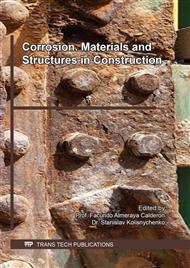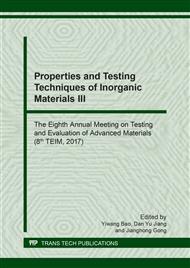[1]
U.M. Angst, B. Elsener, C.K. Larsen, Ø. Vennesland, Chloride induced reinforcement corrosion: Electrochemical monitoring of initiation stage and chloride threshold values, Corrosion Science, 53 (2011) 1451-1464.
DOI: 10.1016/j.corsci.2011.01.025
Google Scholar
[2]
A. Chaipanich, T. Nochaiya, W. Wongkeo, P. Torkittikul, Compressive strength and microstructure of carbon nanotubes–fly ash cement composites, Materials Science and Engineering: A, 527 (2010) 1063-1067.
DOI: 10.1016/j.msea.2009.09.039
Google Scholar
[3]
Y. Hu, D. Luo, P. Li, Q. Li, G. Sun, Fracture toughness enhancement of cement paste with multi-walled carbon nanotubes, Construction and Building Materials, 70 (2014) 332-338.
DOI: 10.1016/j.conbuildmat.2014.07.077
Google Scholar
[4]
S. Musso, J.-M. Tulliani, G. Ferro, A. Tagliaferro, Influence of carbon nanotubes structure on the mechanical behavior of cement composites, Composites Science and Technology, 69 (2009) 1985-(1990).
DOI: 10.1016/j.compscitech.2009.05.002
Google Scholar
[5]
G.Y. Li, P.M. Wang, X. Zhao, Pressure-sensitive properties and microstructure of carbon nanotube reinforced cement composites, Cement and Concrete Composites, 29 (2007) 377-382.
DOI: 10.1016/j.cemconcomp.2006.12.011
Google Scholar
[6]
P.K. Mehta, P.J.M. Monteiro, Concrete, Microstructure, Properties, and Materials, McGraw-Hill Companies, Third Edition (2006).
Google Scholar
[7]
W. Yodsudjai, T. Pattarakittam, Factors influencing half-cell potential measurement and its relationship with corrosion level, Measurement, 104 (2017) 159-168.
DOI: 10.1016/j.measurement.2017.03.027
Google Scholar
[8]
V. Leelalerkiet, J.-W. Kyung, M. Ohtsu, M. Yokota, Analysis of half-cell potential measurement for corrosion of reinforced concrete, Construction and Building Materials, 18 (2004) 155-162.
DOI: 10.1016/j.conbuildmat.2003.10.004
Google Scholar
[9]
S.J. Jaffer, C.M. Hansson, Chloride-induced corrosion products of steel in cracked-concrete subjected to different loading conditions, Cement and Concrete Research, 39 (2009) 116-125.
DOI: 10.1016/j.cemconres.2008.11.001
Google Scholar
[10]
G. Qiao, B. Guo, Z. Li, J. Ou, Z. He, Corrosion behavior of a steel bar embedded in a cement-based conductive composite, Construction and Building Materials, 134 (2017) 388-396.
DOI: 10.1016/j.conbuildmat.2016.12.087
Google Scholar
[11]
B. Han, L. Zhang, S. Sun, X. Yu, X. Dong, T. Wu, J. Ou, Electrostatic self-assembled carbon nanotube/nano carbon black composite fillers reinforced cement-based materials with multifunctionality, Composites Part A: Applied Science and Manufacturing, 79 (2015).
DOI: 10.1016/j.compositesa.2015.09.016
Google Scholar
[12]
G.Y. Li, P.M. Wang, X. Zhao, Mechanical behavior and microstructure of cement composites incorporating surface-treated multi-walled carbon nanotubes, Carbon, 43 (2005) 1239-1245.
DOI: 10.1016/j.carbon.2004.12.017
Google Scholar



